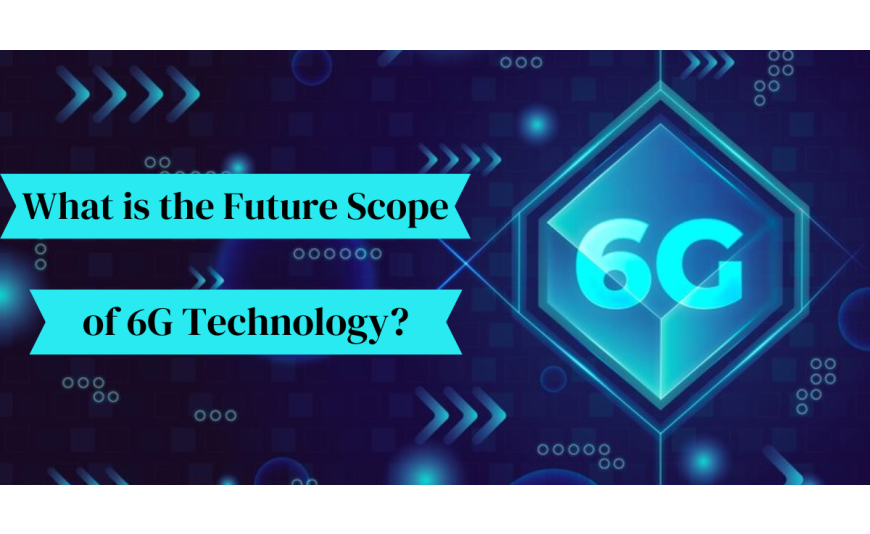
With the rapid advancement in wireless communication, we have seen an incredible journey from 2G to 5G, enhancing connectivity, speed, and efficiency. Now, the next big leap in technology is 6G (Sixth-Generation Wireless Technology), which is expected to revolutionize digital interactions, automation, and data exchange.
6G is envisioned to be significantly faster, with ultra-low latency and highly intelligent network capabilities driven by AI, machine learning, and advanced IoT. While 5G is still being adopted worldwide, researchers and tech giants are already working on 6G’s framework, with an expected rollout by 2030 or beyond.
In this blog, we will explore the future scope of 6G technology, its core innovations, applications, challenges, and the global roadmap leading to its implementation.
Read Also:- Transform Consumer ROI with 5G and Edge Tech
Evolution from 5G to 6G
The transition from 5G to 6G is not just about higher speed but also about creating a more connected and intelligent ecosystem. Below are some key differences and expected improvements:
Faster Data Speeds – While 5G offers speeds up to 10 Gbps, 6G is expected to reach 1 Tbps, making real-time data processing seamless.
Ultra-Low Latency – 6G will drastically reduce latency to below 1 millisecond, enabling near-instantaneous communication, crucial for applications like autonomous vehicles and remote surgeries.
Higher Frequency Spectrum – Moving from millimeter waves (mmWave) in 5G to terahertz (THz) spectrum in 6G, allowing for better signal strength and ultra-fast data transmission.
AI-Driven Network – Unlike 5G, which primarily enhances speed and efficiency, 6G will integrate AI and machine learning to optimize network performance dynamically.
Full-Spectrum Connectivity – 6G will seamlessly connect humans, machines, and digital environments through smart sensors, autonomous devices, and immersive technologies like holography and extended reality (XR).
Read Also:- How Do Smartphones Simplify Daily Life?
Core Technologies Driving 6G
To achieve its futuristic vision, 6G will rely on several breakthrough technologies, including:
Terahertz (THz) Spectrum – 6G will operate on THz frequencies, enabling unprecedented data rates and bandwidth capacity.
AI & Machine Learning – Networks will become self-optimizing, predictive, and highly efficient, reducing energy consumption and improving overall performance.
Quantum Communication – 6G is expected to integrate quantum computing and cryptography, ensuring highly secure data transmission and tackling cyber threats.
Edge Computing & IoT Expansion – The Internet of Things (IoT) will evolve further with 6G, enabling smart cities, industrial automation, and advanced healthcare solutions.
Holographic and Extended Reality (XR) – 6G will support holographic calls, immersive VR experiences, and real-time 3D interactions, transforming remote work, entertainment, and education.
Future Applications of 6G
With these advanced capabilities, 6G will impact several industries, shaping the way we interact with technology. Here are some potential applications:
1. Smart Cities & Automation
6G will enhance urban infrastructure with intelligent networks, smart traffic management, and automated public services, leading to energy-efficient and sustainable cities.
2. Holographic Communication & Extended Reality (XR)
With ultra-fast speeds, holographic telepresence and 3D communication will become a reality, making video conferencing more immersive and lifelike.
3. 6G in Healthcare
Remote Surgeries – Ultra-low latency will enable robotic surgeries from thousands of miles away.
AI-Driven Diagnostics – 6G will enhance real-time medical imaging and AI-assisted diagnostics, improving healthcare outcomes.
4. Industrial Automation & Smart Manufacturing
Factories will use 6G-powered IoT to automate supply chains, robotics, and real-time monitoring, leading to greater efficiency and reduced costs.
5. Space & Underwater Communication
6G will enable seamless global coverage, including deep-sea and space communication, supporting satellite-based internet networks.
Read Also:- How to Remove and Prevent Spyware from Your Phone?
Challenges in 6G Implementation
While 6G technology holds great promise, several challenges must be addressed before its widespread adoption:
Infrastructure & Investment – Developing 6G-ready infrastructure will require massive investment in network hardware, spectrum allocation, and research.
Spectrum Availability – The THz spectrum is still under research, and its allocation for commercial use remains a hurdle.
Cybersecurity & Privacy Risks – With increased connectivity, ensuring data security and preventing cyber threats will be critical.
Energy Consumption – 6G will demand high power consumption, necessitating energy-efficient solutions to minimize environmental impact.
Read Also:- Why Do Some Affordable Smartphones Have Higher Resale Value?
Global Efforts and Timeline for 6G
Several countries and tech giants are actively working on 6G development.
China, the USA, Japan, and South Korea are leading 6G research with government and corporate investments.
Companies like Nokia, Samsung, Huawei, and Ericsson are testing 6G prototypes and network simulations.
Expected Launch – The first commercial rollout of 6G is anticipated by 2030, with research and standardization ongoing until then.
Conclusion
6G technology is set to redefine digital communication by offering unparalleled speed, intelligence, and security. From holographic calls and AI-driven automation to smart healthcare and space communication, 6G will be a game-changer for industries and consumers alike.
However, its implementation comes with challenges, including infrastructure costs, spectrum availability, and cybersecurity concerns. As global research continues, 6G is expected to transform the world in ways we can only imagine today.
As we move towards the future, staying connected with the latest technology is essential. If you’re looking for affordable yet high-quality devices, check out Reloved Gadgets for the best-refurbished Smartphones that keep you ahead in the digital era!











Write a comment